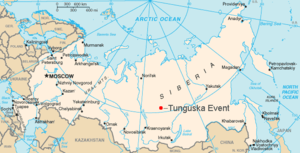Tunguska event
| Tunguska event | |
|---|---|

Location of the event in Siberia (modern map)
|
|
| Event | Explosion in forest area (10–15 Mtons TNT) |
| Time | 30 June 1908 |
| Place | Podkamennaya Tunguska River in Siberia, Russian Empire |
| Effects | Flattening 2,000 km2 (770 sq mi) of forest |
| Damage | Devastation to local plants and animals A few damaged buildings No reported human fatalities |
| Cause | Probable air burst of small asteroid or comet |
| Coordinates | 60°55′N 101°57′E / 60.917°N 101.950°E |
The Tunguska event was a large explosion that occurred near the Stony Tunguska River, in Yeniseysk Governorate (now Krasnoyarsk Krai), Russia, on the morning of 30 June 1908 (N.S.). The explosion over the sparsely populated Eastern Siberian Taiga flattened 2,000 km2 (770 sq mi) of forest yet caused no known human casualties. The explosion is generally attributed to the air burst of a meteoroid. It is classified as an impact event, even though no impact crater has been found; the object is thought to have disintegrated at an altitude of 5 to 10 kilometres (3 to 6 miles) rather than hit the surface of the Earth.
The Tunguska event is the largest impact event on Earth in recorded history. Studies have yielded different estimates of the meteoroid's size, on the order of 60 to 190 metres (200 to 620 feet), depending on whether the body was a comet or a denser asteroid.
Since the 1908 event, there have been an estimated 1,000 scholarly papers (mainly in Russian) published on the Tunguska explosion. In 2013, a team of researchers published analysis results of micro-samples from a peat bog near the center of the affected area showing fragments that may be of meteoritic origin.
Early estimates of the energy of the air burst range from 10–15 megatons of TNT (42–63 PJ) to 30 megatons of TNT (130 PJ), depending on the exact height of burst estimated when the scaling-laws from the effects of nuclear weapons are employed. However, modern supercomputer calculations that include the effect of the object's momentum find that more of the energy was focused downward than would be the case from a nuclear explosion and estimate that the airburst had an energy range from 3 to 5 megatons of TNT (13 to 21 PJ).
...
Wikipedia
